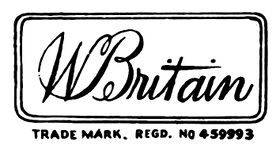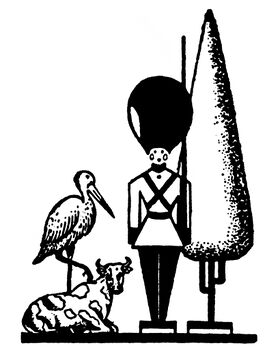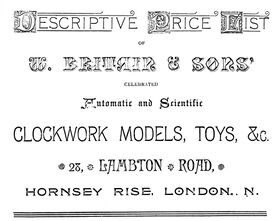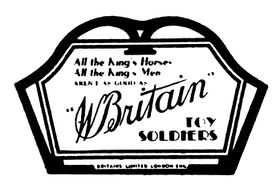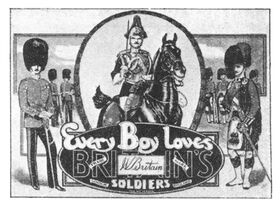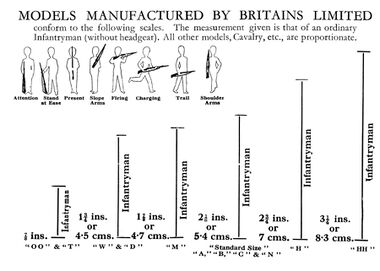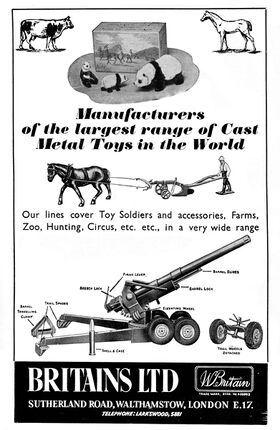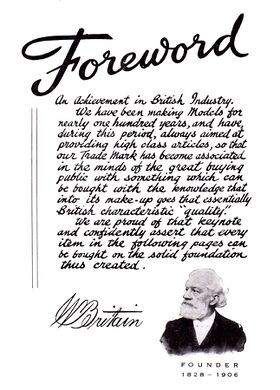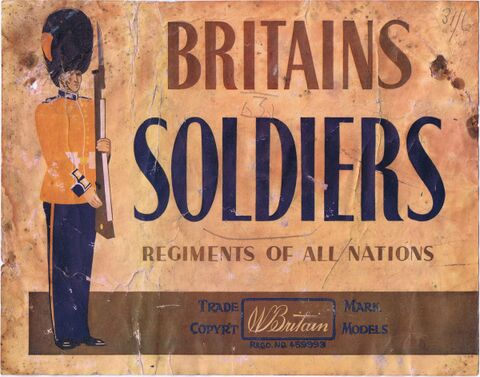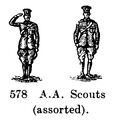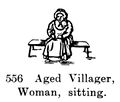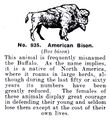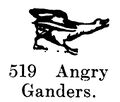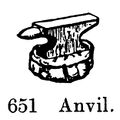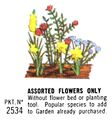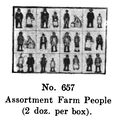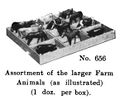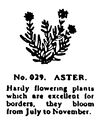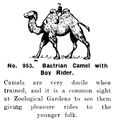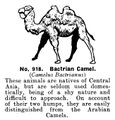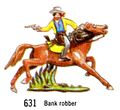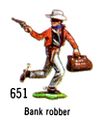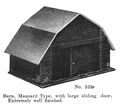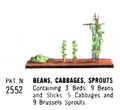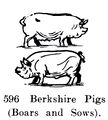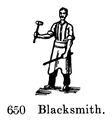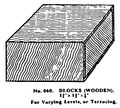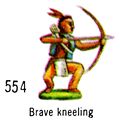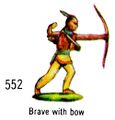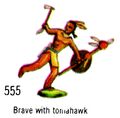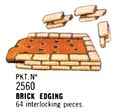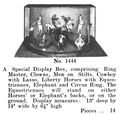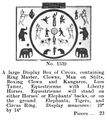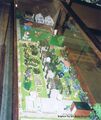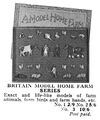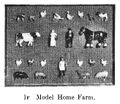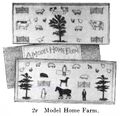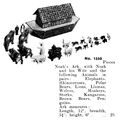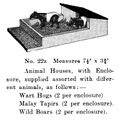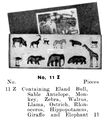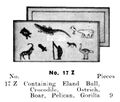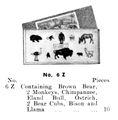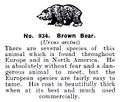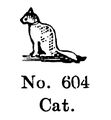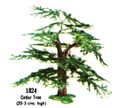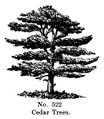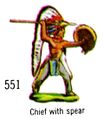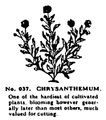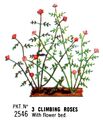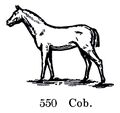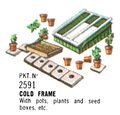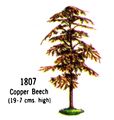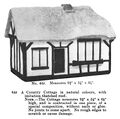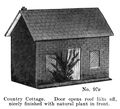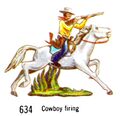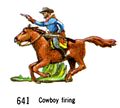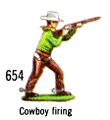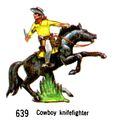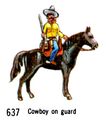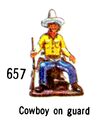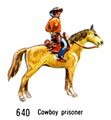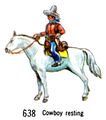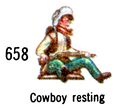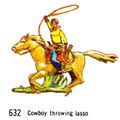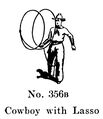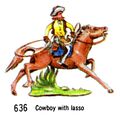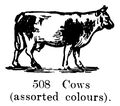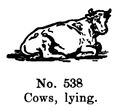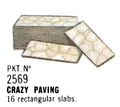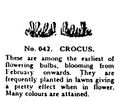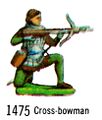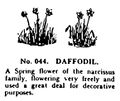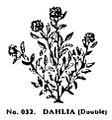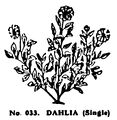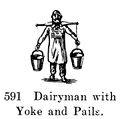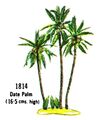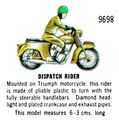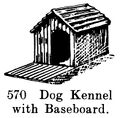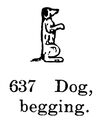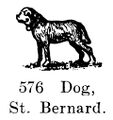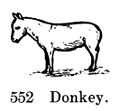Category:Britains Ltd
~1880: "Descriptive Price List of W. Britain and Sons, celebrated Automatic and Scientific Clockwork Models, Toys, Etc. [image info]
"All the King's Horses and all the King's Men aren't as good as W. Britain's Toy Soldiers", point-of-sale advertising circa 1940. There were six different cards in this series, including cards for Britains Farm, Zoo, etc. [image info]
~1940: "Every boy loves Britains Toy Soldiers", point-of-sale advertising [image info]
~1940: Britains' Figures - size chart (1940) [image info]
1956: Britains Ltd. trade advert mentioning the zoo, circus and farm ranges [image info]
1958: Foreword to the Britains Ltd. catalogue, with picture of William Britain [image info]
Britains Limited, or William Britain was the UK's largest producer of cast lead toys, and pioneered the hollow-casting process.
Name variations
The company name suffered badly from a wandering apostrophe, moving logically from W. Britain and Britain's, to Britains' when there was more than one "Mr. Britain" involved, and eventually the apostrophe escaped altogether leaving the name as Britains.
Company origins
William Britain Senior began his career as a 'Brass Cock Maker', and by 1880 had a broadsheet catalogue listing and illustrating a number of clockwork novelties such as The Mechanical Foot Race, The Mechanical Dog, The Mechanical Bear, Don Quixote and the Windmill and The Equestrienne. The catalogue also included a couple of wheeled road-rollers of different sizes, which Britains were keen to point out were "... made of solid castings, and not stamped tin, like most of the foreign rubbish that is now sold" (!).
Britains' enthusiasm for casting paid off, and in ~1893 the company started producing the toy soldiers that would make William Britain a household name, using the hollowcasting process.
Despite the fact that imports from Germany dominated the toy market, Britains continued to grow, with production only slowing/stopping during the First and Second World Wars.
The hollowcasting advantage
"Hollowcasting" produced hollow (rather than solid) cast lead figures, normally without a visible exit hole. The advantages of hollowcasting were:
- Keeping the figures hollow meant that less metal was needed per figure.
- using hollow figures meant that the pieces cooled faster, and could be turned out of the moulds with less delay , allowing a single mould to be used to produce more figures during a working day.
The combination of increased output and lower material costs, both of which allowed retail prices to be reduced, meant that the company's pieces could compete with the bulk-produced German figures of that period.
Hollowcasting methods
The two main types of hollowcasting were:
- filling a mould, allowing some of the molten metal to form a skin on the inside of the mould and then pouring out the excess, or
- only partly filling the mould, and then spinning or rotating it to fully coat the mould's surface.
The process is still generally credited to William Britain in spite of the fact that some early German figures have since been discovered that appear to be hollow despite the fact that they're earlier than 1893. However, these early "anomalous" examples of hollowcasting might have represented individual workers' "tricks and techniques" that they may have preferred to keep secret, whereas William Britain explored and perfected the process so that it could become the default production method for his company.
Box illustration
In the early C20th Britains were producing a mind-bogglingly large range of toy soldiers, which were being sold in stout cardboard boxes distinguished by a single box sticker. In order to create more variety in their packaging while still maintaining a single "Britains" look, the company invested in the services of a commercial artist, Fred Whisstock (1878-1943), who was better known as the cartoonist "Quip" in Vanity Fair. The quality and sheer quantity of Whisstock's output for Britains helped to put even more distance between Britains and the other smaller companies that produced lead figures.
Britains boxes from this period that have Whistock artwork that includes his signiture are considered more desirable and command higher prices from collectors.
Cultural trends between the Wars
While Britains is mostly famous for the company's work on military-themed figures, the company produced a wide range of other lead toy sets and pieces. Before the death of William Britain himself in 1906, this was very much a minor side of the company, with figures based on contemporary football teams being the main exception to the military rule - however his son slowly started branching out more by producing lines based on the Salvation Army, the Boy Scouts and railway figures.
The aftermath of World War One changed things considerably, as public sentiment was less receptive to children's playthings with violent trappings. Sensing this shift in popular mood, Britains began to massively increase their production of lines focused more on civilian life. In 1923 the Britains Model Home Farm series was introduced and served as a springboard for the development of other lines, and by 1940 the catalogue included sets based on Zoos, Gardens, Police, Circuses, Hunting figures, Ambulances, Trucks, Mail vans, Roadsigns and Horse racing.
World War Two saw Britains released their "Lilliput" range, which used 1:76 00-gauge scale to be compatible with model train sets.
The plastic era
The production of metal hollowcast figures ceased in 1966 due to introduction of plastic figures.
From 1966 until the early 1980s, Britains continued to focus on space and agricultural toys as well as plastic military figures. Britains produced a diecast metal Scots Guard figure set (with plastic weapons) in 1973, and in recognition of collectors' interest in traditional metal models, produced a small (but popular) range of all-metal models in 1983.
In 1984, Dennis Britain wished to retire, and no other family shareholder wished to take over the company. It was eventually sold to The Dobson Park Group, who changed the company name to Britain Petite Ltd in 1986. "Metal Models" continued to appear in the main Britains catalogue during the 1980s until 1987 when it was decided that these lines were collectibles rather than toys. They were therefore given their own special four-page catalogue, and during the late '80s the popularity of these figures continued to grow.
The W. Britain Centenary in 1993 saw the launch of the W. Britain Collectors Club, which now has thousands of members all over the world.
Britains "Standard Size"
The default size for Britains items when no scale was indicated, was what Britains referred to as "Standard", which was a scale of one-to-thirty-two. This also happened to be the scale used by the earliest standard scale model railways, "gauge 1". Consequently, Britains accessories could be used with gauge 1 model railways, and gauge 1 accessories could be used with Britains layouts. The use of this default standard scale, which was used on pretty much all of the company's non-military models after WW1 (with the exception of those explicitly scaled for 00-gauge), meant that pieces from different ranges were interoperable: A Britains lead garden could use a wall or fence designed for the farm sets, the farm horses could help out at a Britain's Circus, and a circus performing seal could be part of a Britains zoo. The same fencing and paving worked with all these different ranges, and a figure in overalls might be a farm tractor driver, a zookeeper, or an aeroplane mechanic at an aerodrome populated with 1:32 Britains aircraft.
This use of a standard scale was widely followed by other lead figure manufacturers, and was great for both the customer and the industry generally: a buyer could pick and mix their favourite pieces from different makers, the smaller makers could concentrate on just producing niche pieces without having to create an entire range, and as the market leader, Britains then enjoyed the lion's share of the greater sales due to the resulting healthy ecosystem.
Britains military figures and scale
The problem of scale for model soldiers was more difficult to solve, as military modelling was very much not a "one size fits all" problem: one modeller might only want a diorama of three soldiers in a trench, while a dedicated war-gamer might want to enact a complete battle, requiring a radically different scale. Typically less bothered about accessories than about how many figures on could fit into a given space, the main question of the battle-reenactor was: "how big are the figures?"
Consequently, before World War Two, Britains tended not to quote actual scales for soldiers (as ratios), but instead had a range of different sizes with associated letters, and quoted the scale for each size in terms of the height of an ordinary infantryman (without headgear).
According to the 1940 catalogue, these sizes came out as:
- 00, T
- 7/8 inch
- W, D
- 1 3/4 inch (4.5 cm)
- M
- 1 7/8 inch (4.7 cm)
- "Standard Size", A, B, C, N
- 2 1/8 inch (5.4 cm)
- H
- 2 3/4 inch (7 cm)
- HH
- 3 1/4 inch (8.3 cm)
Further reading
- W. Britain - The History (wbritain.com)
- A Short History of Britains Toy Company (gibbs.fastfreenet.com)
- Gordon Gardiner, and Alistair Morris, The All-Colour Directory of Metal Toys: A Pictorial Guide to the Art of Collecting International Playthings (Salamander Books Ltd, 1984) ISBN 0701818263
Britain family history
Fred Whistock
Subcategories
This category has the following 26 subcategories, out of 26 total.
*
-
- The Circus (display) (16 P, 13 F)
- The Farm (display) (21 P, 11 F)
- The Zoo (display) (74 P, 11 F)
A
C
F
- Britains Farm Sets (24 F)
G
- Britains Floral Garden (display) (16 P, 18 F)
H
- Britains Hospital (2 P)
L
- Britains Lilliput Series (7 P, 5 F)
S
- Swoppet Cowboys (31 F)
- Swoppet Indians (18 F)
- Swoppet Infantry (11 F)
- Swoppet Knights (17 F)
T
- Britains Trees (6 P, 24 F)
- Make-Up Tree Models (Britains) (5 P, 14 F)
Z
- Britains Zoo, animal sets (8 F)
Pages in category ‘Britains Ltd’
The following 153 pages are in this category, out of 153 total.
A
B
- Baby Camel (Britains Zoo 943)
- Baby Chimpanzee (Britains Zoo 978)
- Baby Elephant (Britains Zoo 944)
- Baby Hippopotamus (Britains Zoo 940)
- Baby Kangaroo or Wallaby (Britains Zoo 950)
- Baby Pandas (Britains Zoo 970)
- Baby Rhinoceros (Britains Zoo 951)
- Bactrian Camel (Britains Zoo 918)
- Bactrian Camel with Boy Rider (Britains Zoo 953)
- Barrage Balloon Section (Britains 1749)
- Bear Cubs (Britains Zoo 936)
- Biplane, Pilot and Hangar (Britains 1521)
- Boy and Girl for Howdah (Britains Zoo 939)
- Brick Edging (Britains Floral Garden 2560)
- Britains Circus pieces
- Britains Folk, Family Group (Britains Floral Garden 7530)
- Brown Bear (Britains Zoo 934)
- Bushbuck (Britains Zoo 989)
C
- Carter with Whip, beige smock, moving arm (Britains Farm 505)
- Carter with Whip, grey smock, moving arm (Britains Farm 505)
- Carter with Whip, moving arm (Britains Farm 505)
- Chimpanzee (Britains Zoo 915)
- Civilians lead figures (Britains)
- Clown, Boxing (Britains Circus 447B)
- Coconut Palm (Britains Zoo 919)
- Coconut Palm, boxed (Britains 1815)
- Cold Frame (Britains Floral Garden 2591)
- Cold Frame, Plants with Pots, Seedboxes etc, boxed (Britains Floral Garden 2591)
- Crazy Paving (Britains Floral Garden 2569)
D
F
G
- Garden Fences (Britains Floral Garden 2586)
- Garden Furniture (Britains Floral Garden 2598)
- Garden Roller and Wheelbarrow (Britains Floral Garden 2595)
- Garden Shed (Britains Floral Garden 2590)
- Garden Swing Couch, boxed (Britains Floral Garden 2597)
- Garden Walls (Britains Floral Garden 2585)
- Gazelle (Britains Zoo 963)
- Giant Panda (Britains Zoo 969)
- Giant Tortoise (Britains Zoo 937)
- Giraffe (Britains Zoo 912)
- Gorilla (Britains Zoo 906)
- Gorilla with Pole (Britains Zoo 954)
- Greenhouse (Britains Floral Garden 2592)
- Greenhouse, boxed (Britains Floral Garden 2592)
- Guenon Monkey, walking (Britains Zoo 921)
H
I
K
L
- Landgirls, Brown Jacket, Moving Arm (Britains Farm 535)
- Landgirls, White Jacket, Moving Arm (Britains Farm 535)
- Lawn sections (Britains Floral Garden 2568)
- Lawnmower and Hose (Britains Floral Garden 2594)
- Lion (Britains Zoo 910)
- Lion Cub (Britains Zoo 962)
- Lion Tamer (Britains Circus 448B)
- Lioness (Britains Zoo 911)
- List of Britains Zoo pieces still requiring entries
- Llama (Britains Zoo 923)
M
- Malay Tapir (Britains Zoo 949)
- Man with Wheelbarrow (Britains Farm 547)
- Marching band lead figures (Britains)
- Milk Float with Milkman (Britains Lilliput LV605)
- Milkmaids carrying Pail (Britains Farm 532)
- Milkmaids with Pail on Head, pre-war (Britains Farm 531)
- Miniature Garden lead figures (Britains)
- Monkey (Britains Zoo 904)
- Monoplane and Pilot, RAF, early (Britains 433)
- Monoplane and Pilot, RAF, revised (Britains 433)
- Monoplane and Pilot, USA, revised (Britains 435)
- Mower and Hose, boxed (Britains Floral Garden 2594)
P
- Panther (Britains Zoo 986)
- Passengers, station staff and equipment, lead figures (Britains for Trix 100)
- Pelican (Britains Zoo 909)
- Pelican (Britains Zoo 913)
- Penguin (Britains Zoo 903)
- Pergola and Roses (Britains Floral Garden 2584)
- Polar Bear Walking (Britains Zoo 966)
- Polar Bear, Sitting (Britains Zoo 914)
- Polar Bear, Standing (Britains Zoo 967)
- Predictor with operator (Britains 1728)
R
S
- Sable Antelope (Britains Zoo 945)
- Saloon Car (Britains Lilliput LV602)
- Scots Pine Tree, packaged (Britains 1810)
- Searchlight (Britains 1640)
- Seated Tiger (Britains Zoo 992)
- Sheep, lying (Britains Farm 530)
- Short Monoplane Flying Boat, Knuckleduster (Britains 1520)
- Sir Kreemy Knut tin, small (Sharps Toffee)
- Snow White and the Seven Dwarfs, Disney lead figures (Britains 1654)
- Sound Locator (Britains 1638)
- Sports Car (Britains Lilliput LV601)
- Spotting Chair and Observer (Britains 1731)
- Springbuck (Britains Zoo 988)
- Stone Corner Posts and Iron Fencing (Britains Floral Garden 2587)
- Stork (Britains Zoo 946)
- Street figures, miscellaneous
- Swing Couch (Britains Floral Garden 2597)
T
W
Y
Media in category ‘Britains Ltd’
The following 200 files are in this category, out of 623 total.
(previous page) (next page)- AA Scouts (assorted), Britains Farm 578 (BritCat 1940).jpg 694 × 717; 83 KB
- AA Sign, Crawley, Britains Farm 579 (BritCat 1940).jpg 662 × 1,159; 64 KB
- AA Sign, School, Britains Farm 579 (BritCat 1940).jpg 618 × 1,098; 59 KB
- Aerial view, Britains Floral Garden display (BTMM 2021).jpg 3,000 × 781; 534 KB
- Aeroplane, Pilot and Hangar (Britains 1521).jpg 2,400 × 1,769; 1.03 MB
- Aged Villager, Man, sitting, Britains Farm 555 (BritCat 1940).jpg 716 × 588; 50 KB
- Aged Villager, Woman, sitting, Britains Farm 556 (BritCat 1940).jpg 725 × 619; 62 KB
- American Bison, Britains Zoo No935 (BritCat 1940).jpg 1,309 × 1,433; 301 KB
- Angry Ganders, Britains Farm 519 (BritCat 1940).jpg 451 × 385; 37 KB
- Antirrhinum (Snapdragon), Britains Garden 031 (BMG 1931).jpg 735 × 938; 98 KB
- Anvil, Britains Farm 651 (BritCat 1940).jpg 414 × 413; 41 KB
- Apple Tree, 1801 (BritainsCat 1967).jpg 735 × 520; 75 KB
- Armoured Car, Britains 27d (BritCat 1940).jpg 787 × 607; 65 KB
- Army Cooperation Autogiro Cierva C30, box lid (Britains 1431).jpg 2,400 × 1,154; 641 KB
- Assorted Asters, Britains Floral Garden 2545 (Britains 1966).jpg 682 × 556; 66 KB
- Assortment of Farm Animals, Britains Farm 655 (BritCat 1940).jpg 1,305 × 906; 162 KB
- Assortment of Farm Animals, Britains Farm 664 (BritCat 1940).jpg 1,192 × 973; 129 KB
- Assortment of Farm People, Britains Farm 657 (BritCat 1940).jpg 921 × 939; 129 KB
- Assortment of larger Farm Animals, Britains Farm 656 (BritCat 1940).jpg 1,157 × 966; 138 KB
- Assortment of smaller Farm Animals, Britains Farm 658 (BritCat 1940).jpg 1,300 × 1,024; 155 KB
- Aster, Britains Garden 029 (BMG 1931).jpg 726 × 871; 95 KB
- Autogiro Working Model, Cierva C30, Britains 1392 (1935).jpg 2,400 × 1,412; 1.1 MB
- Baby Camel, Britains Zoo No943 (BritCat 1940).jpg 857 × 605; 60 KB
- Baby Elephant, Britains Zoo No944 (BritCat 1940).jpg 945 × 521; 57 KB
- Baby Hippopotamus, Britains Zoo No940 (BritCat 1940).jpg 1,316 × 985; 185 KB
- Baby Kangaroo or Wallaby, Britains Zoo No950 (BritCat 1940).jpg 1,310 × 841; 115 KB
- Baby Pandas, Britains Zoo No970 (BritCat 1940).jpg 1,085 × 821; 91 KB
- Baby Rhinoceros, Britains Zoo No951 (BritCat 1940).jpg 1,278 × 708; 111 KB
- Bactrian Camel with Boy Rider, Britains Zoo No953 (BritCat 1940).jpg 1,283 × 1,327; 194 KB
- Bactrian Camel, Britains Zoo No918 (BritCat 1940).jpg 1,297 × 1,349; 255 KB
- Balustrading (Long Section), Britains Garden 061 (BMG 1931).jpg 1,953 × 648; 191 KB
- Balustrading (Short Section), Britains Garden 062 (BMG 1931).jpg 896 × 694; 86 KB
- Bank Robber, Britains Swoppets 631 (Britains 1967).jpg 1,419 × 1,305; 662 KB
- Bank Robber, Britains Swoppets 651 (Britains 1967).jpg 833 × 989; 235 KB
- Barn, Mansard Type, Britains Farm 103F (BritCat 1940).jpg 1,600 × 1,408; 307 KB
- Barrage Balloon Section, box lid (Britains 1749).jpg 967 × 2,400; 550 KB
- Barrage Balloon Unit, Britains 1855 (BritCat 1940).jpg 2,220 × 1,585; 201 KB
- Bear Cubs, Britains Zoo No936 (BritCat 1940).jpg 1,287 × 817; 133 KB
- Bench, Britains Floral Garden (BTMM 2021).jpg 1,200 × 800; 429 KB
- Blacksmith with Anvil, Britains Farm 589 (BritCat 1940).jpg 593 × 735; 69 KB
- Blacksmith, Britains Farm 650 (BritCat 1940).jpg 637 × 680; 51 KB
- Blocks (Wooden), Britains Garden 060 (BMG 1931).jpg 1,393 × 1,259; 384 KB
- Boy on Shetland Pony, Britains Farm 600 (BritCat 1940).jpg 549 × 665; 69 KB
- Boy or Girl for Howdah, Britains Zoo No939 (BritCat 1940).jpg 1,313 × 837; 134 KB
- Brave Kneeling, Britains Swoppets 554 (Britains 1967).jpg 860 × 860; 218 KB
- Brave with Bow, Britains Swoppets 552 (Britains 1967).jpg 996 × 1,043; 242 KB
- Brave with Tomahawk, Britains Swoppets 555 (Britains 1967).jpg 1,082 × 1,066; 281 KB
- Brick Edging, Britains Floral Garden (BTMM 2021).jpg 3,000 × 2,000; 1.27 MB
- Brick Edging, Britains Floral Garden 2560 (Britains 1966).jpg 630 × 586; 67 KB
- Britains Circus Set 1442 6pc (BritCat 1940).jpg 1,505 × 929; 146 KB
- Britains Circus Set 1443 10pc (BritCat 1940).jpg 1,533 × 1,200; 228 KB
- Britains Circus Set 1444 14pc (BritCat 1940).jpg 1,522 × 1,456; 231 KB
- Britains Circus Set 1539 23pc (BritCat 1940).jpg 1,509 × 1,689; 299 KB
- Britains Farm, retailers showcard No6 (Britains 1958-01).jpg 1,014 × 680; 173 KB
- Britains Farm, Set 36F (BritCat 1940).jpg 1,897 × 682; 130 KB
- Britains Farm, Set 38F (BritCat 1940).jpg 1,867 × 983; 227 KB
- Britains Farm, Set 39F (BritCat 1940).jpg 1,869 × 1,154; 276 KB
- Britains Farm, Set 53F (BritCat 1940).jpg 1,587 × 666; 164 KB
- Britains Farm, Set 55F (BritCat 1940).jpg 1,845 × 993; 258 KB
- Britains Farm, Set 62F (BritCat 1940).jpg 1,889 × 1,305; 336 KB
- Britains Floral Garden display (1990s).jpg 1,516 × 1,800; 593 KB
- Britains Floral Garden, storage box 1.jpg 3,000 × 2,194; 1.29 MB
- Britains Floral Garden, storage box 2, side view.jpg 3,000 × 2,000; 745 KB
- Britains Floral Garden, storage box 2.jpg 3,000 × 2,365; 1.11 MB
- Britains Floral Garden, storage box 3.jpg 3,000 × 2,032; 1,014 KB
- Britains Floral Garden, storage box 4, end view.jpg 3,000 × 2,000; 636 KB
- Britains Floral Garden, storage box 4, side view.jpg 3,000 × 1,773; 819 KB
- Britains Floral Garden, storage box 4.jpg 3,000 × 1,998; 1.11 MB
- Britains Floral Garden, storage box 5.jpg 3,000 × 1,515; 634 KB
- Britains Folk, family group (Britains Floral Garden 7530).jpg 3,000 × 1,838; 462 KB
- Britains Folk, from above (Britains Floral Garden 7530).jpg 1,600 × 1,067; 268 KB
- Britains Gardening painted lead flowerbed (gauge 0 layout).jpg 2,500 × 973; 1.29 MB
- Britains Lilliput Series, retailers showcard No8 (Britains 1958-01).jpg 1,115 × 627; 180 KB
- Britains Lilliput World, box sticker.jpg 1,827 × 1,009; 125 KB
- Britains Limited 1940.jpg 1,200 × 774; 210 KB
- Britains Limited figure sizes 1940.jpg 1,200 × 856; 108 KB
- Britains Limited Garden Series (BMG 1931).jpg 1,471 × 925; 67 KB
- Britains logo (BritCat 1940).jpg 1,416 × 322; 75 KB
- Britains Ltd (GaT 1956).jpg 1,042 × 1,600; 223 KB
- Britains Ltd graphic, 1958.jpg 1,093 × 1,417; 132 KB
- Britains Ltd logo 1956.jpg 708 × 386; 64 KB
- Britains Mammoth Circus, retailers showcard No9 (Britains 1958-01).jpg 1,800 × 536; 248 KB
- Britains Mammoth Circus, showcard 10 (BritCat 1940).jpg 1,533 × 503; 141 KB
- Britains Miniature Gardening (BMG 1931).jpg 1,815 × 2,200; 858 KB
- Britains Miniature Gardening, Foreword (BMG 1931).jpg 1,615 × 2,200; 449 KB
- Britains Model Farm, showcard 7 (BritCat 1940).jpg 957 × 656; 105 KB
- Britains Model Home Farm (GamCat 1932).jpg 1,335 × 1,600; 457 KB
- Britains Model Home Farm, set 1F (BritCat 1940).jpg 1,308 × 1,132; 371 KB
- Britains Model Home Farm, set 2F (BritCat 1940).jpg 1,380 × 1,334; 422 KB
- Britains Model Home Farm, set 3F (BritCat 1940).jpg 2,205 × 1,237; 578 KB
- Britains Noahs Ark, Set 1550 (BritCat 1940).jpg 1,949 × 1,966; 400 KB
- Britains Soldiers Regiments of all Nations, paper label for box (W Britain).jpg 2,400 × 1,885; 1.23 MB
- Britains Soldiers, retailers showcard No2 (Britains 1958-01).jpg 942 × 744; 153 KB
- Britains Soldiers, showcard 11 (BritCat 1940).jpg 1,740 × 1,286; 349 KB
- Britains Toy Soldiers, showcard 1-6 (BritCat 1940).jpg 929 × 625; 72 KB
- Britains Zoo Enclosure 18z, Mammal House (BritCat 1940).jpg 2,339 × 1,597; 681 KB
- Britains Zoo Enclosure 19z, Polar Bear Pool with Cave (BritCat 1940).jpg 2,391 × 1,353; 518 KB
- Britains Zoo Enclosure 20z, Large Pool (BritCat 1940).jpg 2,431 × 1,716; 562 KB
- Britains Zoo Enclosure 21z, Monkey Hill (BritCat 1940).jpg 2,438 × 1,508; 606 KB
- Britains Zoo Enclosure 22z, Animal Houses (BritCat 1940).jpg 1,331 × 1,327; 253 KB
- Britains Zoo Enclosure 23z, Rock Pool (BritCat 1940).jpg 2,441 × 1,587; 636 KB
- Britains Zoo, displays (Britains 1940).jpg 2,200 × 1,403; 721 KB
- Britains Zoo, retailers showcard No2 (Britains 1958-01).jpg 1,206 × 699; 170 KB
- Britains Zoo, Set 11 Z (BritCat 1940).jpg 1,364 × 1,516; 300 KB
- Britains Zoo, Set 17 Z (BritCat 1940).jpg 1,314 × 1,122; 195 KB
- Britains Zoo, Set 6 Z (BritCat 1940).jpg 1,339 × 1,361; 139 KB
- Britains Zoo, Set 972 (BritCat 1940).jpg 1,131 × 790; 151 KB
- Britains Zoo, Set 973 (BritCat 1940).jpg 1,147 × 829; 152 KB
- Britains Zoo, Set 974 (BritCat 1940).jpg 1,117 × 882; 163 KB
- Britains Zoo, Sets 1 Z to 4 Z (BritCat 1940).jpg 2,613 × 1,753; 621 KB
- Britains Zoological Series heading (Britains 1940).jpg 800 × 451; 46 KB
- Britains Zoological Series, showcard 8 (BritCat 1940).jpg 949 × 641; 105 KB
- British Infantry Swoppets, logo (Britains 1967).jpg 1,200 × 513; 231 KB
- Brown Bear, Britains Zoo 934 (BritCat 1940).jpg 1,305 × 1,113; 212 KB
- Bull, Britains Farm 573 (BritCat 1940).jpg 781 × 616; 92 KB
- Bush Rose, Britains Garden 028 (BMG 1931).jpg 788 × 1,051; 143 KB
- Calves (assorted colours), Britains Farm 509 (BritCat 1940).jpg 631 × 491; 42 KB
- Calves, lying, Britains Farm 534 (BritCat 1940).jpg 549 × 449; 30 KB
- Carters with Whip, Britains Farm 505 (BritCat 1940).jpg 473 × 609; 49 KB
- Cat, Britains Farm 604 (BritCat 1940).jpg 410 × 444; 30 KB
- Cedar Tree, 1824 (BritainsCat 1967).jpg 1,077 × 972; 203 KB
- Cedar Trees, Britains Farm 522 (BritCat 1940).jpg 1,104 × 1,267; 203 KB
- Chicken House and Run, Britains Farm 102F (BritCat 1940).jpg 1,200 × 674; 117 KB
- Chicks (assorted positions), Britains Farm 550 (BritCat 1940).jpg 716 × 523; 41 KB
- Chief with Dagger, Britains Swoppets 553 (Britains 1967).jpg 796 × 1,315; 329 KB
- Chief with Spear, Britains Swoppets 551 (Britains 1967).jpg 947 × 1,098; 346 KB
- Chimpanzee, Britains Zoo No915 (BritCat 1940).jpg 1,305 × 957; 182 KB
- Chrysanthemum, Britains Garden 037 (BMG 1931).jpg 1,049 × 1,192; 168 KB
- Climbing Roses, Britains Floral Garden 2546 (Britains 1966).jpg 760 × 883; 105 KB
- Clown (Boxing), Britains Circus 447 (BritCat 1940).jpg 560 × 784; 37 KB
- Clown with Hoop, Britains Circus 354 (BritCat 1940).jpg 645 × 997; 64 KB
- Clown, Standing, Britains Circus 358 (BritCat 1940).jpg 628 × 809; 51 KB
- Cob, Britains Farm 550 (BritCat 1940).jpg 716 × 673; 62 KB
- Coconut Palm Tree, Britains Zoo No919 (BritCat 1940).jpg 1,306 × 2,016; 310 KB
- Coconut Palm, 1815 (BritainsCat 1967).jpg 892 × 1,203; 136 KB
- Cold Frame, Britains Farm 675 (BritCat 1940).jpg 1,053 × 766; 150 KB
- Cold Frame, Britains Floral Garden 2591 (Britains 1966).jpg 724 × 695; 82 KB
- Cold Frame, Britains Garden 064 (BMG 1931).jpg 1,304 × 888; 187 KB
- Cold Frames, Britains Floral Garden (BTMM 2021).jpg 1,200 × 800; 490 KB
- Coloured Vase, Britains Garden 016 (BMG 1931).jpg 1,024 × 677; 72 KB
- Colts (Shire), Britains Farm 507 (BritCat 1940).jpg 491 × 617; 47 KB
- Conifer, Britains Garden 023 (BMG 1931).jpg 701 × 1,085; 85 KB
- Copper Beech Tree, 1807 (BritainsCat 1967).jpg 708 × 748; 82 KB
- Country Clergyman, Britains Farm 593 (BritCat 1940).jpg 517 × 675; 56 KB
- Country Cottage, Britains Farm 44F (BritCat 1940).jpg 2,236 × 2,209; 762 KB
- Country Cottage, Britains Farm 97F (BritCat 1940).jpg 1,600 × 1,455; 349 KB
- Cowboy and Indian Box Set, Britains Swoppets 7630 (Britains 1967).jpg 1,200 × 953; 824 KB
- Cowboy Firing From Cover, Britains Swoppets 661 (Britains 1967).jpg 1,071 × 847; 297 KB
- Cowboy Firing, Britains Swoppets 634 (Britains 1967).jpg 1,386 × 1,340; 637 KB
- Cowboy Firing, Britains Swoppets 641 (Britains 1967).jpg 1,436 × 1,289; 548 KB
- Cowboy Firing, Britains Swoppets 654 (Britains 1967).jpg 893 × 976; 216 KB
- Cowboy Gunslinger, Britains Swoppets 656 (Britains 1967).jpg 815 × 1,065; 239 KB
- Cowboy Knifefighter, Britains Swoppets 639 (Britains 1967).jpg 1,351 × 1,431; 650 KB
- Cowboy Knifefighter, Britains Swoppets 659 (Britains 1967).jpg 772 × 1,001; 216 KB
- Cowboy On Guard, Britains Swoppets 637 (Britains 1967).jpg 1,231 × 1,394; 480 KB
- Cowboy On Guard, Britains Swoppets 657 (Britains 1967).jpg 798 × 947; 228 KB
- Cowboy Prisoner, Britains Swoppets 640 (Britains 1967).jpg 1,303 × 1,403; 479 KB
- Cowboy Prisoner, Britains Swoppets 660 (Britains 1967).jpg 780 × 1,162; 267 KB
- Cowboy Resting, Britains Swoppets 638 (Britains 1967).jpg 1,260 × 1,431; 474 KB
- Cowboy Resting, Britains Swoppets 658 (Britains 1967).jpg 786 × 713; 172 KB
- Cowboy Swoppets, logo (Britains 1967).jpg 1,200 × 517; 311 KB
- Cowboy Throwing Lasso, Britains Swoppets 632 (Britains 1967).jpg 1,505 × 1,502; 620 KB
- Cowboy with Lasso, Britains Circus 356 (BritCat 1940).jpg 701 × 813; 47 KB
- Cowboy With Lasso, Britains Swoppets 636 (Britains 1967).jpg 1,429 × 1,370; 694 KB
- Cowboy With Lasso, Britains Swoppets 652 (Britains 1967).jpg 860 × 1,155; 290 KB
- Cowboys Four Figure Window Box, Britains Swoppets 7620 (Britains 1967).jpg 1,200 × 700; 471 KB
- Cowboys Four Figure Window Box, Britains Swoppets 7621 (Britains 1967).jpg 1,200 × 706; 440 KB
- Cowboys Three Figure Window Box, Britains Swoppets 4656 (Britains 1967).jpg 1,283 × 971; 570 KB
- Cowboys Three Figure Window Box, Britains Swoppets 4657 (Britains 1967).jpg 1,262 × 982; 561 KB
- Cows (assorted colours), Britains Farm 508 (BritCat 1940).jpg 707 × 627; 78 KB
- Cows, feeding, Britains Farm 539 (BritCat 1940).jpg 718 × 551; 69 KB
- Cows, lying, Britains Farm 538 (BritCat 1940).jpg 658 × 606; 45 KB
- Cowshed, Britains Farm 99F (BritCat 1940).jpg 1,200 × 810; 147 KB
- Crazy Paving, Britains Farm 668 (BritCat 1940).jpg 613 × 747; 63 KB
- Crazy Paving, Britains Floral Garden 2569 (Britains 1966).jpg 572 × 512; 50 KB
- Crazy Paving, Britains Garden 009 (BMG 1931).jpg 713 × 871; 78 KB
- Crocus, Britains Garden 042 (BMG 1931).jpg 1,168 × 986; 138 KB
- Crossbowman, Britains Swoppets 1475 (Britains 1967).jpg 827 × 976; 286 KB
- Curate, Britains Farm 592 (BritCat 1940).jpg 462 × 592; 47 KB
- Daffodil, Britains Garden 044 (BMG 1931).jpg 1,157 × 969; 130 KB
- Dahlia (Double), Britains Garden 032 (BMG 1931).jpg 901 × 969; 125 KB
- Dahlia (Single), Britains Garden 033 (BMG 1931).jpg 933 × 958; 151 KB
- Dairyman with Yoke and Pails, Britains Farm 591 (BritCat 1940).jpg 719 × 713; 69 KB
- Date Palm, 1814 (BritainsCat 1967).jpg 806 × 946; 118 KB
- Delphinium, Britains Garden 039 (BMG 1931).jpg 995 × 1,345; 135 KB
- Dispatch Rider, Britains Swoppets 9698 (Britains 1967).jpg 1,575 × 1,590; 742 KB
- Dog for kennel, lying, Britains Farm 569 (BritCat 1940).jpg 409 × 506; 40 KB
- Dog for kennel, sitting, Britains Farm 569 (BritCat 1940).jpg 425 × 545; 40 KB
- Dog Kennel with Baseboard, Britains Farm 570 (BritCat 1940).jpg 653 × 640; 104 KB
- Dog Kennel, Britains Farm 569 (BritCat 1940).jpg 643 × 516; 72 KB
- Dog, begging, Britains Farm 637 (BritCat 1940).jpg 390 × 465; 29 KB
- Dog, St Bernard, Britains Farm 576 (BritCat 1940).jpg 478 × 506; 47 KB
- Dogs (assorted colours), Britains Farm 513 (BritCat 1940).jpg 624 × 499; 40 KB
- Don't Say Zoo, Say Britains Zoo (Britains 1940).jpg 1,200 × 820; 233 KB
- Donkey, Britains Farm 552 (BritCat 1940).jpg 530 × 492; 38 KB
